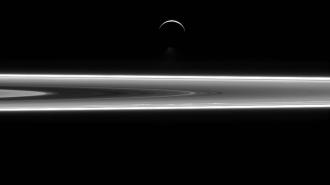The James Webb Space Telescope has spotted a “surprisingly large” plume of water vapor emanating from Enceladus, one of Saturn’s many moons. The plume sprawled across over 6,000 miles, NASA said in a statement — roughly the distance from Los Angeles to Buenos Aires.
According to the space agency, this is the first time such a large plume has been spotted, and the first time that researchers have gotten a picture of how Enceladus’ plumes feed the water supply of the Saturn system.
A paper describing the discovery has been accepted by Nature Astronomy (and can be perused now, for free, as a preprint).
A peek beneath a Saturnian sea: Enceladus holds a special place in the minds of astrobiologists. Beneath its icy exterior lies a global salty sea, making the marine moon a prime target in the search for extraterrestrial life. Within those waters could be living organisms, perhaps fed by energy from hydrothermal vents, Nature noted.
When plumes like the one spotted by JWST emerge — usually from vents, dubbed “tiger stripes,” which score the surface — they carry hints of that locked-away ocean.
When NASA’s Cassini probe studied the moon, it managed to fly through a plume, gathering insight into what was within it. Cassini found silica, which suggested seafloor vents as the origin of the plumes; ice particles; and carbon-based chemicals like ammonia, methane, and carbon dioxide, Nature reported.
The space telescope is not up close and personal like the probe was, but its placement and sensors help provide new context for what researchers are seeing in these plumes.
Like a donut: What the team saw was a water source impacting the entire Saturn system.
“The orbit of Enceladus around Saturn is relatively quick, just 33 hours. As it whips around Saturn, the moon and its jets are basically spitting off water, leaving a halo, almost like a donut, in its wake,” lead author Geronimo Villanueva, of NASA’s Goddard Space Flight Center, said. “In the Webb observations, not only was the plume huge, but there was just water absolutely everywhere.”
That water donut, called a “torus,” shared space with Saturns’ largest and outermost ring, the E-ring. Webb allows the researchers to see for the first time how that giant plume then feeds water to the rest of the Saturn system and rings. The telescope revealed that only about 30% of the water stays within the torus, while the rest feeds the Saturnian system.
Future missions: NASA plans on using the Webb as the primary way to observe Enceladus, with the data they gather helping to define future missions to the marine moon. Future explorations, including one undertaken by an orbiter/lander and (far cooler and more sci-fi) a snake robot, have already been proposed.
“Right now, Webb provides a unique way to directly measure how water evolves and changes over time across Enceladus’ immense plume, and as we see here, we will even make new discoveries and learn more about the composition of the underlying ocean,” co-author Stefanie Milam of NASA Goddard said.
“Because of Webb’s wavelength coverage and sensitivity, and what we’ve learned from previous missions, we have an entire new window of opportunity in front of us.”
We’d love to hear from you! If you have a comment about this article or if you have a tip for a future Freethink story, please email us at tips@freethink.com.
